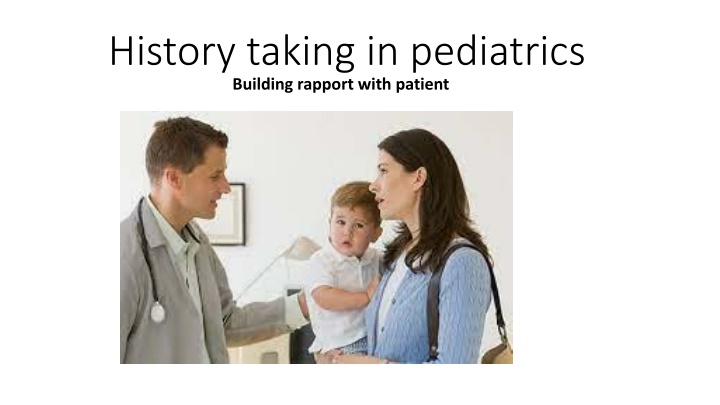
Pediatrics: Building Rapport for Effective History Taking in Children
Learn the essential steps for building rapport with pediatric patients to facilitate history taking in a medical setting. Explore strategies for establishing trust, communication, and comfort with young patients to ensure thorough and accurate healthcare assessments.
Download Presentation

Please find below an Image/Link to download the presentation.
The content on the website is provided AS IS for your information and personal use only. It may not be sold, licensed, or shared on other websites without obtaining consent from the author. If you encounter any issues during the download, it is possible that the publisher has removed the file from their server.
You are allowed to download the files provided on this website for personal or commercial use, subject to the condition that they are used lawfully. All files are the property of their respective owners.
The content on the website is provided AS IS for your information and personal use only. It may not be sold, licensed, or shared on other websites without obtaining consent from the author.
E N D
Presentation Transcript
History taking in pediatrics Building rapport with patient
/ 8:30 10:30 - / ) 2023 - 2024 ( / history taking in pediatrics 8/10 / . + 2 + 1 9/10 . 1 2 10/10 1 2 11/10 1 2 . :
Acute diarrhea/Duration/(characters of stool) Acute diarrhea/Duration/(characters of stool) Frequency per day Color Consistency Quantity Contains blood Contains mucous Odor Tenesmus & rectal prolapse
Associated symptoms : Associated symptoms : fever& All systems Symptoms suggestive of dehydration( thirst , urine output , lethargy ) GIT : (vomiting , abdominal pain or distension ) Tenesmus (in young child crying during defecation ) Diarrhea related to feeding , Recent weight loss CNS- Convulsion Resp.- Renal Skin parenteral cause of diarrhea (pneumonia, UTI, otitis media)
P Prognosis rognosis 5 . Treatment prescribed prior and during hospital management Progress of symptom (worsening or improved)
Convulsion/onset/ onset/description description Aura ( depend on the age of the patient ) Progression (focal or generalized ) and type Consciousness lost or preserved Loss of sphincter control (depend on the age of the patient ) Duration of the seizure Post-ictal state Neurological deficit How is it stopped? (spontaneous or by medication) Single or repeated
Prior condition Fever Trauma Medication Vaccination Previous similar attack
Associated symptoms Associated symptoms Respiratory symptom or flu like symptom Vomiting Diarrhea Skin rash Other e.g. Photophobia, headache (age dependent ) Family history of seizure Progress of symptoms and management
Shortness Shortness of breathing of breathing /Onset/Details/Severity/ /Onset/Details/Severity/Associated symptoms Associated symptoms continuous or Periodic attack diurnal variation history of choking or playing with small objects Aggravating factors e.g. smoke, dust ,cold air,exercise. Relieving factors Change with position Interfered with feeding or activities Interfered with sleeping presence of cyanosis altered level of consciousness at rest or during activity Cough (productive or not) and rhinconjunctivitis Noisy breathing Fever leg edema skin rash
Communication skills Communication skills Build relationship with patient (introduce his name, taking patient name ) Listening (giving appropriate time for the patient without interruption, facilitating/ encouraging patient to tell his story the patient Summarization, periodically (listening in consequences the relevant data, adding / removing data in response to the patient) Empathy; pick up (verbal & nonverbal patient cues), show (verbal and nonverbal empathy cues) Using conning type of questioning Patient's perspective (patient's idea, concern, feeling, hope, effect on life)
Review of systems: Ask screening questions for symptoms within systems other than the presenting system cover all the organ systems General: activity, tiredness, sleep, school absence, weight loss. Cardiovascular: Faints, cyanosis. Respiratory: Cough, wheeze, shortness of breath Gastrointestinal: Appetite, vomiting diarrhoea, constipation, abdominal pain Genitourinary: Enuresis, dysuria, frequency, age of menarche, dysmenorrhea ENT : Earache , hearing impairment, recurrent sore throat, enlarged glands. Neurological: Fits, faints/funny turns, headaches, hearing and vision Skin : pallor, any lesions or rashes Musculoskeletal: Joint pain or swelling Development: gross motor, fine motor, social.
Past history Past history Same condition Previous hospitalization (frequency) Atopy , hay fever , eczema Cardiac problem Previous illnesses should be listed in chronological order and hospital admissions recorded Ask specifically about childhood infections, such as measles, mumps, rubella and chickenpox.
F Feeding eeding history history Type of feeding? (if formula ask about the type of the formula ) Number of feeding daily How was it prepared? Volume (Number of ounce ) taken at each feeding The duration of feeding Number of bottle The way of sterilization of bottles Were there any problems with feeding?
Feeding history Feeding history Did he/she gain weight? At what age complementary foods first introduced? Type of foods introduced Way of administration of food (by spoon or in bottle ) Any food preference Any Problems related to foods ( e.g allergy, intolerance) caloric intake
Growth and development: Ask about milestones and school performance Are there any areas of concern? The following questions about achievement of major milestones usually suffice: Smiling Head control Fixing and following Sitting independently crawling or bottom shuffling Walking Age at first spoken word Ability to use a cup and spoon Ability to understand and obey simple commands Ability to identify different parts of the body Age at successful toilet training.
School Performance This is a useful question to identify developmental problems or the impact of a chronic illness on older children. Questions include: Stage Missing days Attendance Grades Relation with friends and teachers
Family history Who is in the family and who lives at home? History of parents; age health of parents consanguinity as cousin marriages History of siblings; number of brothers and sisters their ages illness Any illnesses that run in the family Does anyone have a disability Deaths in childhood?
Social history: Which school or nursery does the child attend? Jobs Smoking and Financial situation at home Type of house including number of rooms Drugs and allergies: What drugs is the child taking and are there any allergies? Any known food allergies? Why do you think he is allergic to that substance?
